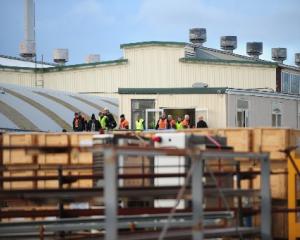Now the situation has come full circle for Hillside as fears for its very survival again arise.
This week, KiwiRail awarded an estimated $29 million manufacturing contract to a Chinese company in what has been described as a potentially terminal blow to the workshops.
The state-owned company, now chaired by Wellington businessman John Spencer, also confirmed it would not build or assemble locomotives in New Zealand, after a review found it could cost 70% more to get the job done locally than in China.
Workers were told China CNR Corporation would build the first 300 of 3000 container flat-deck wagons KiwiRail wants to replace its ageing fleet.
Hillside-based Rail and Maritime Transport Union national president Jim Kelly said the tender announcement was a devastating pre-Christmas blow for the about 160 workshop workers - about the same number when the future of the workshops was on the line in 2000.
Ten years later, the same fate hangs over the workshops. It is the second time this year they have been knocked back by KiwiRail.
In May, the company rejected a New Zealand build of its $500 million contract for electric trains for Auckland.
Cynics are starting to believe the National-led Government, which vehemently opposed in Opposition the buy-back of the rail network by the previous Labour government, is about to sell off the rail business.
However, all might not be lost, according to industry sources, who asked not to be named because of the amount of emotion surrounding the issue.
Some of the sources had attended meetings or talked privately with KiwiRail chief executive Jim Quinn and still believed this week that Mr Quinn remained "passionate" about the future of Hillside and was not intending to close it down.
"It is not as bad as it seems. CNR are only building the first of 300 wagons - a small part of a bigger picture. There are a lot more to be made. Losing the first contract doesn't mean to say all is lost."
One source said he did not think the situation was as dire as some were making it out to be.
The engineering cluster in Dunedin employed about 10,000 people in manufacturing, proving it was not a dead industry as some suggested when Fisher and Paykel Appliances closed its Silverstream plant and moved offshore.
There were dozens of suppliers feeding Hillside and that was why the workshops were so successful.
"The key strength is Dunedin people and getting to their expertise much faster."
Another business person who had met Mr Quinn believed that having Hillside as number two or three in the pecking order was not such a bad thing as it gave the workshops a chance to work on components and maintenance.
"Quinn knows the importance of Hillside to Otago and the whole of New Zealand. He is aware that maintenance and new projects are Hillside's bread and butter."
The workshops had the chance to build a long-term relationship with the Chinese.
The strength of the workshop staff was shown by their "anger" at being overlooked.
"They are working-class people standing up to fight for their survival. I wish the Otago rugby team had the same spirit. The engineering cluster in Dunedin is an industry leader but `Joe Average' doesn't realise that most of the time."
Hillside workshops and Dunedin, in general, needed to decide whether it was better to have skilled engineering staff working on a variety of projects well into the future or pull all staff on to one big project then wait another three years for another big project, the business person said.
The high value of the New Zealand dollar was also seen as a problem, one exporter told the Otago Daily Times.
Too much was being made of low Chinese wages compared with high wages in Dunedin.
It is assumed the Chinese will make money on the bid, which was 25% less than the bid from Hillside, but their competitive advantage must be seen in the light of the Chinese yuan being artificially low and the "unreasonably high" New Zealand dollar.
"It is inevitable that the Chinese currency will eventually move up and our dollar will eventually move down, but in the meantime we will lose a valuable industry.
"With no industry here, the country will be forced to buy overseas. Our workers are not inefficient or overpaid. The exchange rate creates an artificial barrier."
Hillside history
• In May 1875, one of several repair shops planned along the hill side (hence the name Hillside) was completed. It housed ancillary departments and provided accommodation for three locomotives. A carriage shop was completed the following year.
• By 1880, the Hillside Workshops were unable to meet the demand for repair facilities and extensions began in order to keep pace with the requirements of a rapidly developing railway system.
• By 1905, Hillside employed 400 workers and was the second-largest engineering plant in New Zealand.
• The buildings, machinery and shop methods had become obsolete by the 1920s. At that time, the Railways Department undertook to reorganise all railway workshops in New Zealand. By 1928, Hillside Workshops had been completely rearranged, with several large new buildings brought into use. The first half of the 20th century was considered the "golden age" of rail and Hillside numbers peaked at 1200.
• By the 1950s, with the increased competition of road and air transport, the golden age ended, with many lines, services, stations and facilities being closed. The deregulation of road transport in the 1980s added significantly to the loss of rail business. The lack of investment in infrastructure and rolling stock to modernise and be more competitive led the government of the day to sell the rail assets to the private sector.
• By 2000, Hillside had hit a low of about 160 employees in an ageing site that saw little investment over the decades.
• In 2003, a financially strapped Tranz Rail was taken over by Toll and investments in assets increased.
• In 2008, the Labour government bought back the rail business.
Source - Hillside Engineering website.



